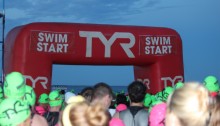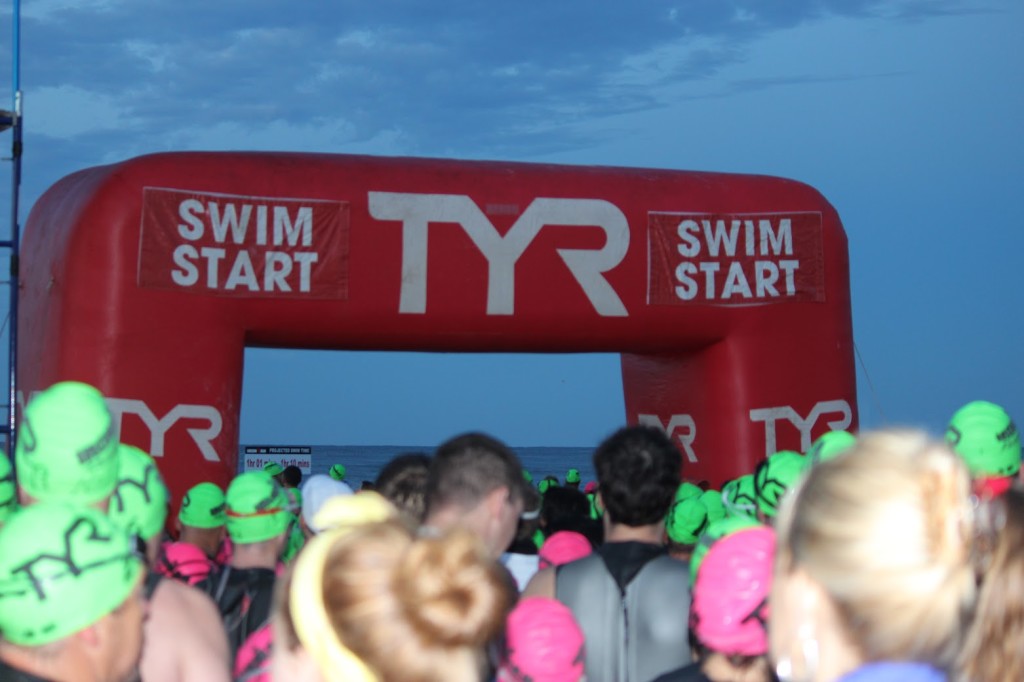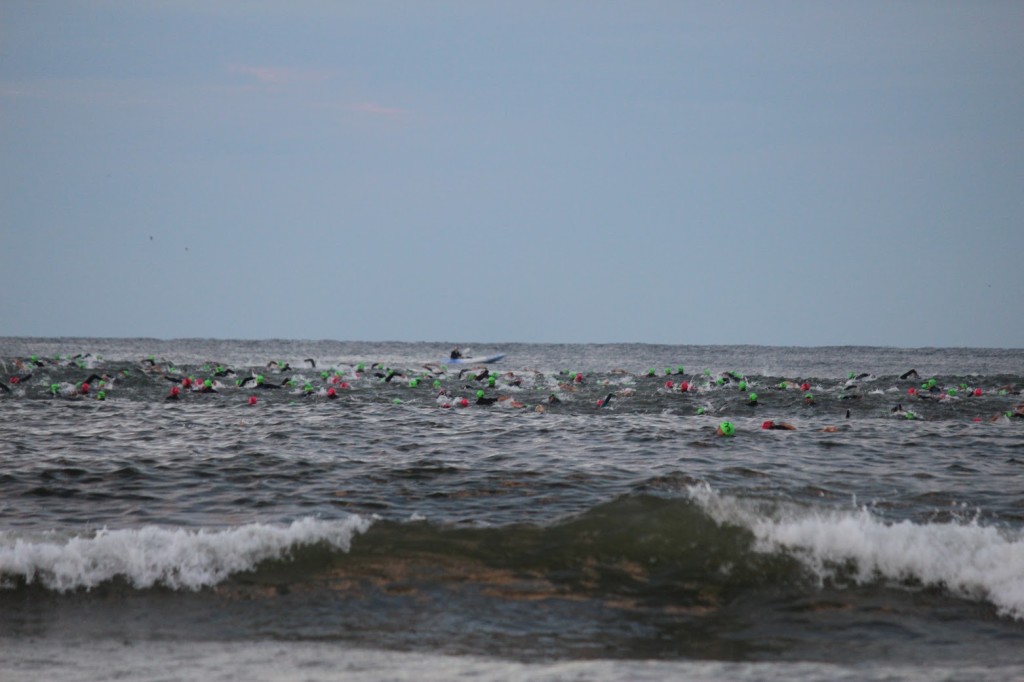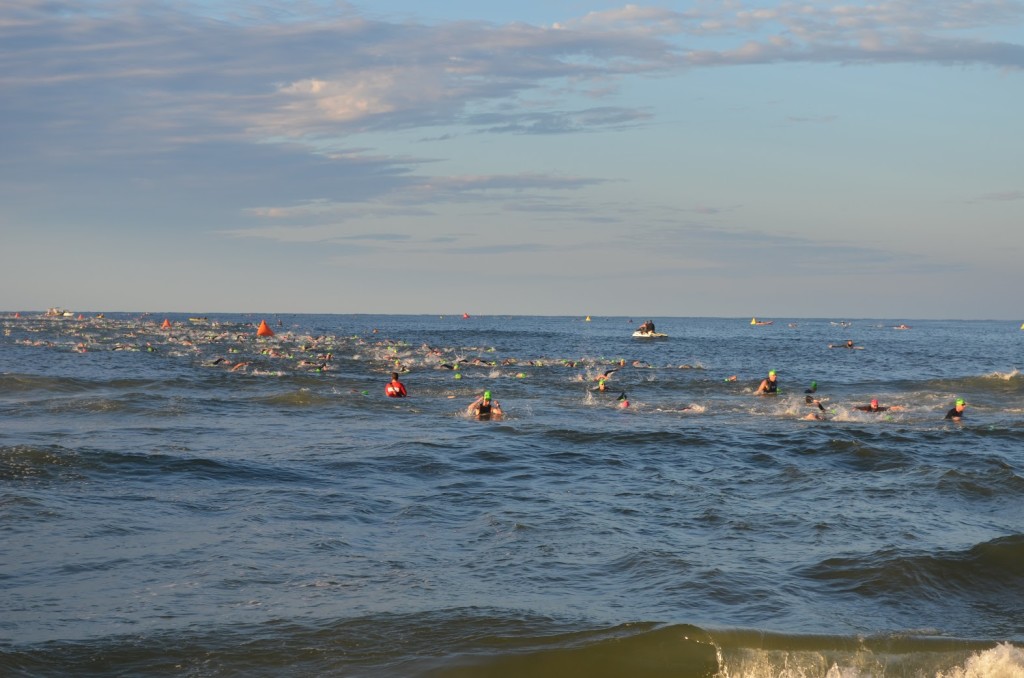IRONMAN Florida Swim and Swim Smart


When the cannon went off my prediction, unfortunately, came true. I watched the efficient skilled dolphin divers slip past the breakers in record time, while I flopped around boxed in and at the mercy of the water walruses (aka punching/kicking dudes wrapped in wetsuits)
The result of the self seeded mass start (along with the choppy water) was the most physical swim I have experienced after Kona, in eight Ironmans. The upside was that I got over my fear of being kicked and punched. At some point you just have to know that it will happen and accept it. I felt much calmer staying under the ocean as much as possible. With now eight Ironmans under my belt, the pro is that I have moved beyond the adrenaline rush of “I’m going to die” at the beginning of the swim. The con is that I haven’t yet replaced it with the confidence of “I’m going to rock this swim” and instead have a vague feeling of dread and unease that probably isn’t the best state of mind for performance.
Thoughts on Swim Smart
As far as Swim Smart, I disliked the self-seeded mass start, and do not believe it leads to a safer swim for most. The reason is that it pushes athletes of similar ability together forcing continuous contact the entire time. A random mass start, on the other hand, naturally spreads people out. The self-seeded mass start reminded me of the Kona swim, where there is literally nowhere to go for clear water, since similar ability folks are in a narrow band of swim times. I can see how the self-seeded mass could perhaps benefit slower swimmers, as it could lead to less folks being swum over. However, if folks seed themselves properly to begin with (fastest swimmers in the front to slowest in the back) I don’t see how it would help beyond that.
To me it seems that the stated purpose of Swim Smart would be better served by either separating the start into two waves by gender or further into waves by age group. If separated in this way, that would improve safety and volunteer access to anyone experiencing issues, yet also allow folks to race head to head with their age group competition. Although one of the issues with Florida is lack of daylight hours, it seems that safety could still be improved by separating the field into a few waves and spreading them out by mere minutes. Also, you may not be able to start much earlier because of the sunrise, but you can certainly end later. It seems to me that the issues of safety and the importance of a head to head race within categories (why a tt start is not a good idea) would trump any concerns about the cutoff being exactly midnight.
Also, I have to wonder if swim smart is playing a part in WTC increasing field size. The field at IRONMAN Florida this year was several hundred athletes greater than in 2011. With FL already being crowded and rife with purposeful drafting, it seems that it would be unwise to increase the field any more, if your intention is to promote a safe and clean race.
As for my personal performance, I saw a few things I could do differently were I to attempt this swim again. One mistake is that I didn’t see which way the current was going at the beginning of the swim. The knowledge that the prevailing current was west to east would have helped me on the second loop, when I got in much too early found myself at odds with the current.
The first loop was 32:xx so my second must have been much slower. The second negative thing that happened (which again was reminiscent of Kona 2012) was that I swallowed a lot of water. I pretty much have swallowed a lot of water in every Ironman I’ve done, the differences have to do with the quality of water to see what happens next. The water in Wisconsin, Texas, St George, and Louisville 2013 must have not been so terrible. The water in Lou 2011 and the ocean in general have not treated me as well. The added roughness to this year’s Im FL meant I swallowed more water and had a slower swim time than I expected.
The clock was at 1:20 when I popped out and for a minute I thought that was the actual time instead of the pro time. I would have believed it as the second lap seemed to take longer than expected and I started feeling nauseous and sore at the end. I ran to the first stripper and it was Cheryl Williams. I asked her what time it was and she said 8:11. I was relieved but also unhappy to be over 5 minutes off the time I had hoped to achieve.
Based on how I was feeling, I thought I had swallowed too much water, but it wasn’t nearly as bad as Kona, when I couldn’t even jog straight because I was dizzy. I started jogging to transition, then I was woken up when Joseph sprinted past me. Hello, it’s a race! I could at least nab a better transition time than 2011! Overall, I was happy to be out of the swim, uninjured, and without major catastrophe. I tried to put my time behind me and move forward.
The change tent was surprisingly empty but it was more a reminder how few women comprised the field at FL this year, than an indication that my swim was better than I thought. There was also a low number of volunteers which didn’t bother me because I didn’t have much to do. I shoved my inhaler, gels, and salt into my back pocket and my instant ice pack into my top. Then I ran to my bike and jumped on..





3 Comments
Shanks · November 10, 2013 at 9:04 pm
When I heard about their swim start plan for IMFL I was a bit concerned also. However I believe the rough surf made it far worse then it would have otherwise been. At IMCDA they had the same “corral system” but you could only enter the water through a banner no bigger than the size in your 1st pic. I liked that system as it spread things out a bit and I only ever had contact 1x during the entire 2.4 mile course. Hopefully they will find better balances in the future since this was their first year of doing it… but I also concur that it is a way for them to increase entries per race.
Bethany · November 10, 2013 at 9:51 pm
I definitely agree with you and should have mentioned that. The rough water contributed to the roughness. Hopefully they’ll be able to identify the best way forward with Swim Smart through trial and error…
Hosting · August 2, 2017 at 4:59 am
Other races exist that are of the same distance as an Ironman triathlon but are not produced, owned, or licensed by the World Triathlon Corporation. Among the participants were representatives of both the Mid-Pacific Road Runners and the Waikiki Swim Club, whose members had long been debating which athletes were more fit, runners or swimmers.
Comments are closed.